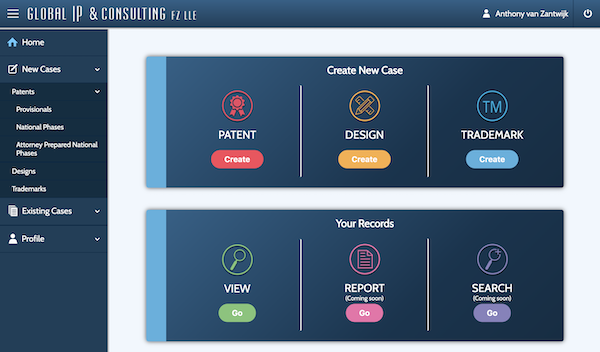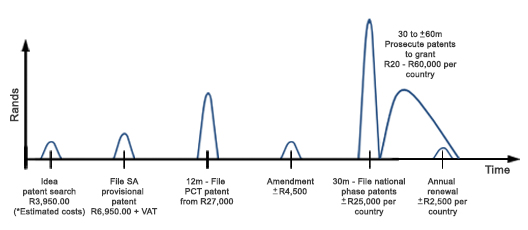Patent Pending
To mark a product “Patent Pending“, you must file a patent application, i.e.:
- a provisional patent application (filed in any one of the 177 Paris Convention countries);
- a complete patent application;
- a PCT / international patent application filed with WIPO (Geneva);
- a national phase patent application; or
- a convention complete patent application.
Each of the above applications are patent applications. They just differ in price and are filed at different stages of the patent process.
We suggested starting with a South African provisional patent application – see our reasons.


Step 1 – File a provisional patent application
As long as an invention is secret, you can file a provisional patent application. The provisional patent application:
- reserves your right to file patents in 177 countries (including US, China, UK, EU, Australia, Canada, Russia, Japan, South Africa) for a year;
- gives you an application number – this is your Patent Pending Number and permits you legally to mark your product “PATENT PENDING” worldwide; and
- allows you publicly to disclose, sell and use your invention without impacting your patent rights.
A resident of the UK, Australia or New Zealand need not file his provisional patent in his own country (where the filing cost may be very high). 177 countries are members of the Paris Convention. This convention allows residents of member countries to file provisional patents in any other member country and secure Patent Pending Numbers in all 177 member countries. So, a resident of the UK is not required to file a UK provisional patent at a cost of hundreds of Pounds. Instead, he may select a cheaper Paris Convention member country in which to file his provisional patent. And, many inventors do exactly this.
Irrespective of the member country in which the UK resident files his provisional patent, he gets the same rights – a Patent Pending Number, and the right to claim priority from that provisional patent application in 177 countries.

The cheapest and easiest way to get a Patent Pending Number is to file a provisional patent application through either GlobalIPCo or Iptica. GlobalIPCo has identified the Paris Convention member country that:
- is the cheapest in which to file a provisional patent application;
- is 100% online;
- is obliged by law to maintain provisional patent applications secret (and not to publish them);
- does not subject provisional patent applications to substantive examination; and
- can issue a Patent Pending Number in a day, while offering an official online register to confirm ownership of the Patent Pending Number.

To get a Patent Pending number all you need to do is:
- input the title of your invention;
- provide inventor and applicant names and addresses;
- upload a document that “fully describes” your invention – no specific format is dictated – try our Patent Template and our easy provisional patent filing guide;
- download, sign, scan and upload pre-populated forms; and
- pay $49 (GlobalIPCo) or $99 (Iptica) by credit card.
The process takes less than 5 minutes.
Within a day, you will receive a Patent Pending Number that allows you to: mark your product “PATENT PENDING” worldwide; sell your product worldwide; publicly disclose your invention; raise funding via Kickstarter or Indiegogo; and market your product on the internet.
Step 2 – File a PCT / complete / convention patent application
By the one-year anniversary of filing your provisional patent application, you should:
- file a PCT / international patent application if you intend to file corresponding complete patents in 3 or more countries; or
- file a convention complete patent application in the handful of countries in which you intend to secure patent rights.
Where a complete patent application is filed in the same country in which the provisional patent application was filed, it is called a “complete patent application“, and where a complete patent application is filed in a country other than the country in which the provisional patent application was filed, it is called a “convention complete patent application“. Basically, there is no difference between a complete patent application and a convention complete patent application.

During the period from filing a complete patent application / convention complete patent application to grant of the application (which typically takes 12-30 months from filing), you may continue to mark your product “PATENT PENDING” in the countries in which complete patent applications / convention complete patent applications have been filed.
The benefit of filing a PCT patent application is that this extends the period within which you are required to file complete patents in countries in which you wish to secure patent protection from 12 to 30 months from filing your provisional patent application. During the 18 month PCT process, you also receive a search report and an examination report.
During the 18 month long PCT patent application period (i.e. from the date of filing your PCT patent application to 30 months from the filing date of the provisional patent application), you may mark your product “PATENT PENDING” in the 156 member countries of the Patent Cooperation Treaty (PCT).
At the end of the PCT process (i.e. by 30 months from filing the provisional patent application), you will need to file national phase patents in the countries in which you wish to secure patent rights. There is no difference between: a “national phase patent application” on the one hand; and a “complete patent application” or a “convention complete patent application” on the other hand – the former merely followed a PCT patent application, whereas the latter did not.
During the period from filing a national phase patent application to grant of the application (which typically takes 12-30 months from filing), you may continue to mark your product “PATENT PENDING” in the countries in which national phase patent applications have been filed.
After grant of a complete patent application, a convention complete patent application or a national phase patent application, you may mark your product “PATENTED” in the country of grant.
In summary:
- during the 12 month provisional patent phase, you may mark your product “PATENT PENDING” in 177 countries for only $49;
- during the further 18 month PCT patent phase, you may mark your product “PATENT PENDING” in 156 countries, but to file a PCT patent application will cost anywhere from $1,400 to $6,000; and
- during the further 12-30 month national phase patent phase, you may mark your product “PATENT PENDING” in the countries in which national phase patents have been filed, but to file national phase patent applications typically costs between $475 (e.g. South Africa) and $2,500 per country. The most affordable South African national phase patent filing ($399) is offered by GlobalIPCo (for whom we are the exclusive South African agent).
The advantage of marking your product “PATENT PENDING” is that it warns competitors not to copy your invention. Even though you may intend to follow the provisional patent – PCT patent – National phase patent process (totalling at least 42 months), your competitors know that you need not wait for 42 months for grant of your patent in every country. For example, should an Australian resident file a provisional patent application in South Africa (a Paris Convention member country), and should a competitor start copying the Patent Pending product 2 weeks thereafter in Germany, the Australian resident may immediately accelerate filing of the German convention complete patent application, prosecute that application to grant and then prevent the competitor from continuing to make, market, sell or use the patented product in Germany. Should the competitor have, during the period before grant of the German patent, marketed and advertised the product within Germany, the Australian patentee will ultimately benefit from the market demand the German competitor has paid to create. In other words, even though the Patent Pending phase does not give the patentee enforceable rights to institute infringement proceedings, the deterrence effect of a “PATENT PENDING” mark typically keeps competitors at bay in all 177 countries during the 12 month period from getting a Patent Pending Number (by filing a provisional patent application).
